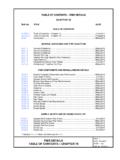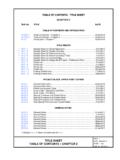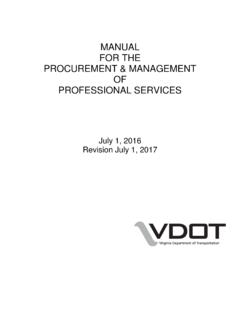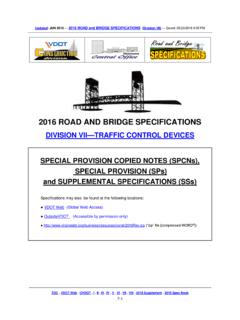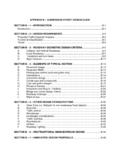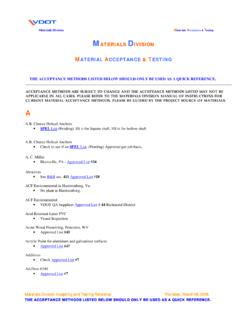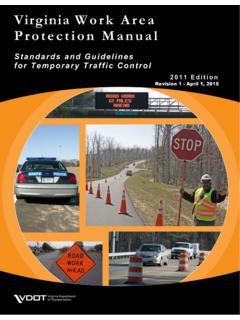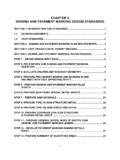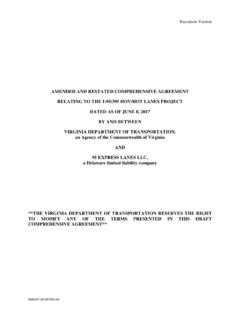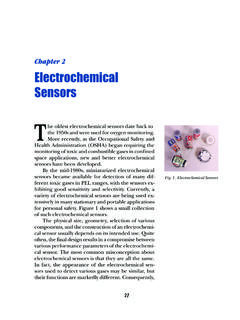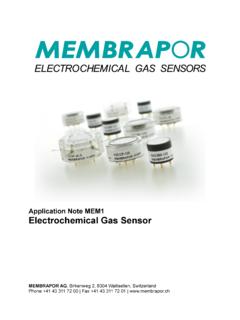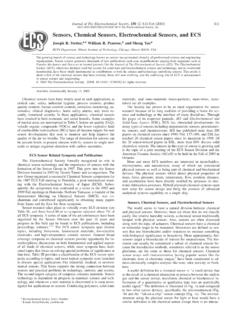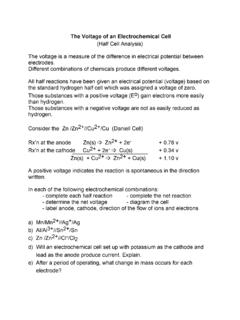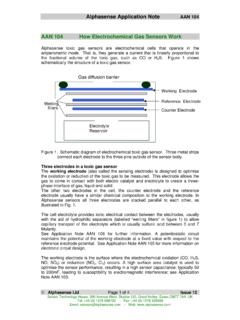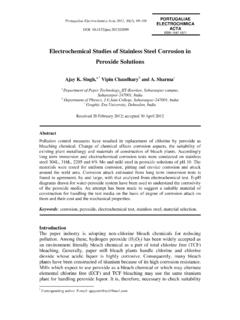Transcription of FINAL REPORT TRIAL APPLICATION OF ELECTROCHEMICAL CHLORIDE ...
1 FINAL REPORT TRIAL APPLICATION OF ELECTROCHEMICAL CHLORIDE EXTRACTION ON CONCRETE BRIDGE COMPONENTS IN VIRGINIA Gerardo G. Cleme a, Principal Research Scientist Virginia Transportation Research Council Donald R. Jackson, Senior Program Manager Office of Technology Applications Federal Highway Administration (The opinions, findings, and conclusions expressed in this REPORT are those of the authors and not necessarily those of the sponsoring agencies.)
2 Virginia Transportation Research Council (A Cooperative Organization Sponsored Jointly by the Virginia Department of Transportation and the University of Virginia) In Cooperation with the Department of Transportation Federal Highway Administration Charlottesville, Virginia VTRC 00-R18 April 2000 ii Copyright 2000 by the Virginia Department of Transportation. iiiABSTRACT ELECTROCHEMICAL CHLORIDE extraction is a new technique for mitigating CHLORIDE -induced corrosion of the reinforcing bars in concrete bridges.
3 To demonstrate the feasibility of applying this technique on full-sized concrete bridge members and to identify needed improvements to the technology, the technique was tried on two concrete deck spans and three concrete piers in Virginia. For the two deck spans, an anode system consisting of felt-sandwiched catalyzed titanium mesh kept wet by an electrolyte was used. An electrical charge of 741 to 1077 A-hr/m2 was applied between the anode and the steel bar for 57 or 58 days. Approximately 72 to 82 percent of the CHLORIDE ions was removed from the concrete at the depth of the first mat of steel bars. For the three piers, an anode system consisting of wet cellulose fibers and steel or titanium mesh was used.
4 An electrical charge of 249 to 382 A-hr/m2 was applied between the anode and the steel bars for 72 to 77 days. The system for the piers appeared to be relatively less effective than that for the deck spans, removing approximately 13 to 53 percent of the CHLORIDE ions from the concrete near the steel bars. In addition, more problems were encountered with this treatment system. No damage to the concrete attributable to the treatment was observed with either system, and it is likely that shorter treatment times would have sufficed. Based on potential surveys, the bars in the concrete piers were still passive at 4 years after their treatment.
5 To facilitate the comparison between ELECTROCHEMICAL CHLORIDE extraction and other corrosion control options, such as impressed-current and galvanic cathodic protection, preliminary information on the costs and projected service lives of all options is provided. FINAL REPORT TRIAL APPLICATION OF ELECTROCHEMICAL CHLORIDE EXTRACTION ON CONCRETE BRIDGE COMPONENTS IN VIRGINIA Gerardo G. Cleme a, Principal Research Scientist Virginia Transportation Research Council Donald R. Jackson, Senior Program Manager Office of Technology Applications Federal Highway Administration INTRODUCTION Since concrete is permeable, it is susceptible to the intrusion of CHLORIDE ions when exposed to deicing salts or surrounded by seawater.
6 The CHLORIDE will eventually reach the depth of the reinforcing steel and accumulate in the surrounding concrete until reaching a concentration sufficient to initiate corrosion. This corrosion threshold is approximately kg/m3, depending on the type of cement used and the concentration of the hydroxide ions in the concrete. The heterogeneous nature of concrete leads to uneven distributions of CHLORIDE ions, oxygen, and moisture across a concrete structure. This heterogeneity, in turn, creates ELECTROCHEMICAL cells with different potentials along the surfaces of neighboring steel bars, or even individual bars, which serve to drive the corrosion reactions.
7 Eventually, the stress exerted by the accumulating corrosion products causes the concrete in some areas to delaminate and then spall. Different stages of this deterioration process are typically found in a structure exposed to CHLORIDE intrusion. Until recently, rehabilitating concrete bridge decks and piers involved only removing the damaged concrete and then patching. However, this practice was found to lead to the introduction of new ELECTROCHEMICAL cells between the new CHLORIDE -free concrete in the patches and the surrounding old concrete that contained varying amounts of CHLORIDE . In turn, these new cells accelerated corrosion and damage of the old concrete, often within a few years of the repair.
8 An understanding of this phenomenon led to the awareness that additional measures had to be taken to avoid the consequent wasteful cycles of repair and damage. Consequently, many transportation agencies adopted the practice of placing a concrete overlay over an entire deck after repairing the damaged concrete. This practice appeared to be beneficial in delaying the corrosion process by depriving the concrete of oxygen and moisture. However, since a large amount of CHLORIDE is still trapped in the overlaid concrete, steel corrosion will set in again. Regardless of the true long-term benefit of this practice, it is not applicable to concrete piers since overlays cannot be applied to this type of bridge member.
9 2 Since steel corrosion is an ELECTROCHEMICAL process, once it occurs in a concrete structure only an ELECTROCHEMICAL measure, such as cathodic protection (CP) or ELECTROCHEMICAL CHLORIDE extraction (ECE), can stop it or slow it down to a significant extent. CP, which stops corrosion by cathodically polarizing the metal being protected, has long been applied in many industries. Now, it has been proven to be effective in halting the corrosion of steel bars in concrete and, thereby, in preventing untimely and costly bridge replacements. In practice, however, the effectiveness of a CP system on a bridge lasts only as long as the system is properly maintained.
10 Although the type of electrical maintenance required is often simple and inexpensive, it is new to many bridge engineers. However, the present cost of CP systems and the prospect of additional maintenance burdens have probably dampened interest in CP. Therefore, the use of CP has been limited to major bridges and, in some states, mostly to concrete piers. ECE is based on the principle that opposite electrical charges attract and like charges repel. The ECE process is as follows: (1) a suitable metal is placed or attached to the surface of a concrete structure, (2) an electrical field is applied between this metal and the embedded steel bars by the passage of a direct current through the concrete (as in CP) in such a manner that the bars become negatively charged and the metal becomes positively charged, and (3) the negatively charged CHLORIDE ions (Cl-) in the concrete are drawn away from the steel bars and toward the surface of the concrete.
